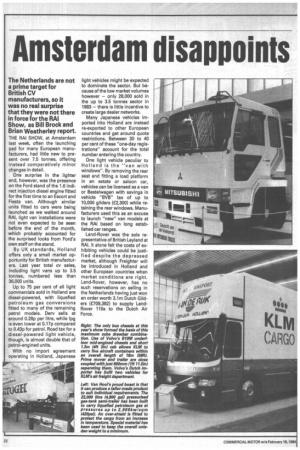Amsterdam disappoints
Page 24

If you've noticed an error in this article please click here to report it so we can fix it.
The Netherlands are not a prime target for British CV manufacturers, so it was no real surprise that they were not there in force for the RAI Show, as Bill Brock and Brian Weatherley report.
THE RAI SHOW, at Amsterdam last week, often the launching pad for many European manufacturers, had little new to present over 7.5 tonnes, offering instead comparatively minor changes in detail.
One surprise in the lighter end, however, was the presence on the Ford stand of the 1.6 indirect injection diesel engine fitted for the first time to an Escort and Fiesta van. Although similar units fitted to cars were being launched as we walked around RAI, light van installations were not even expected to be seen before the end of the month, which probably accounted for the surprised looks from Ford's own staff on the stand.
By UK standards, Holland offers only a small market opportunity for British manufacturers. Last year total cv sales, including light vans up to 3.5 tonnes, numbered less than 36,000 units.
Up to 75 per cent of all light commercials sold in Holland are diesel-powered, with liquefied petroleum gas conversions fitted to many of the remaining petrol models. Dery sells at around 0.28p per litre, while lpg is even lower at 0.17p compared to 0.43p for petrol. Road tax for a diesel-powered light vehicle, though, is almost double that of petrol-engined units.
With no import agreement operating in Holland, Japanese light vehicles might be expected to dominate the sector. But because of the low market volumes however — only 28,000 sold in the up to 3.5 tonnes sector in 1983 — there is little incentive to create large dealer networks.
Many Japanese vehicles imported into Holland are instead re-exported to other European countries and get around quota restrictions. Between 30 to 40 per cent of these "one-day registrations" account for the total number entering the country.
One light vehicle peculiar to Holland is the "van with windows". By removing the rear seat and fitting a load platform in an estate or saloon car, vehicles can be licensed as a van or Bestelwagen with savings in vehicle "BVB" tax of up to 10,000 gilders (£2,300) while retaining the rear windows. Manufacturers used this as an excuse to launch "new" van models at the RAI based on long established car ranges.
Land-Rover was the sole representative of British Leyland at RAI. It alone felt the costs of exhibiting vehicles could be justified despite the depressed market, although Freighter will be introduced in Holland and other European countries when market conditions are right. Land-Rover, however, has no such reservations on selling in the Netherlands having just won an order worth 3.1m Dutch Glid ers (£709,382) to supply LandRover 110s to the Dutch Air Force.




















































































